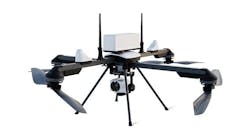Sep. 2--Amazon.com Inc. said Monday it received federal approval to establish a fleet of drones and will begin limited tests of package deliveries to customers in the U.S., although a number of key steps remain before widespread use of the technology will be allowed.
The approval from the Federal Aviation Administration is a milestone in Amazon's push to use unmanned aircraft to deliver packages to global consumers.
Amazon didn't say when exactly it would begin customer tests in the U.S. The company also has testing sites in Canada, Austria, the U.K. and other international locations, although at the moment it can only perform tests involving customers in the U.S. and U.K.
Routine drone deliveries to U.S. consumers are still years away, partly because the FAA needs to complete rules for remote identification of more than 480,000 drones currently registered for commercial operations, and issue separate rules permitting drones to fly regularly over populated areas.
Despite the investments and interest in potential drone deliveries by startups as well as deep-pocketed early adapters such as Amazon, package deliveries won't proceed beyond limited trials in the U.S. until new federal regulations go into effect.
Amazon has now joined United Parcel Service Inc. and Wing, a unit of Google parent Alphabet Inc., in gaining approval to operate unmanned air fleets in the U.S. for tests involving customer deliveries.
Amazon has sought regulatory approval for a broader range of drones and over a larger geographic area than its competitors. The company said Monday that the approval from the FAA isn't tied to a specific drone model but operations of a fleet.
"This is a long time coming for Amazon," former FAA Administrator Michael Huerta said. "They are developing real-time data, which is helpful to the [FAA] and gives Amazon a lot of experience in working through the growing pains of getting this business established."
Amazon Chief Executive Jeff Bezos made the ambitious prediction in 2013 that drone-delivered packages would arrive at the doors of customers in five years. Although the company completed its first test flight in England in 2016, the process has taken longer than many top Amazon executives initially expected.
Wing last year began to deliver food and other supplies to customers in Virginia. The company has been conducting tests in partnership with Walgreens and FedEx Corp., UPS, which received FAA approval to set up an airline fleet last year, has been using its drones to carry medical supplies at a hospital network in Raleigh, N.C.
Other companies such as Uber Technologies Inc. have also conducted limited drone-delivery tests in the U.S., although they haven't received the level of FAA approval as Amazon, Wing and UPS.
The drone-delivery industry has become saturated with companies. Both startups and legacy companies have invested based on the belief that commercial drones can speed up delivery efficiency and will emerge as an important tool for a number of industries, from the health-care sector to restaurants.
That conviction has been cemented by the growth in noncontact package deliveries during the coronavirus pandemic.
Before widespread deliveries will be allowed, the FAA still needs to establish alternate, automated air-traffic-control networks because current systems using existing radars and human controllers won't be able to handle the large increases in drone operations that are expected as package-delivery options proliferate.
Preparatory work to facilitate routine drone deliveries to households has been under way for more than four years, and senior FAA officials have indicated they expect White House approval and publication of needed regulations to come before the end of the year.
The high hopes for other pilot programs, however, haven't always succeeded. A first-of-its-kind coordinated effort between federal, state, local, tribal and industry participants--unveiled with fanfare in 2017 by the Department of Transportation--is slated to expire in October. The program will end without identifying a path toward large-scale flights of drones beyond visual sight of pilots or observers on the ground.
It has been more than a year since Amazon consumer chief Jeff Wilke at an Amazon conference in Las Vegas said the company's drones would be delivering packages to customers "within months."
Amazon earlier this year hired former Boeing executive David Carbon to lead the drone program. Mr. Carbon succeeded Gur Kimchi, who had been important in launching the program but didn't have the aviation background Mr. Carbon does.
Amazon said it envisions delivering packages from its warehouses to customers in less than 30 minutes. Its latest drone design, a hexagonal-shaped machine it unveiled last year, is designed to carry packages weighing 5 pounds and fly a round-trip distance of about 15 miles, according to the company.
"We will continue to develop and refine our technology to fully integrate delivery drones into the airspace, and work closely with the FAA and other regulators around the world to realize our vision of 30 minute delivery," Mr. Carbon said in a written statement Monday.
Dan Elwell, the FAA's No. 2 official, told an industry conference in July the agency is pursuing what he called a cautious "crawl, walk, run" strategy for opening up the skies for drones.
"We're still crawling right now," Mr. Elwell said during a virtual conference associated with the U.K.'s Farnborough International Airshow, adding the next phase will feature semiautonomous vehicles flying in high-density airspace. "We're not there yet, but we're close."
___
(c)2020 the Bangkok Post (Bangkok, Thailand)
Visit the Bangkok Post (Bangkok, Thailand) at www.bangkokpost.com
Distributed by Tribune Content Agency, LLC.

